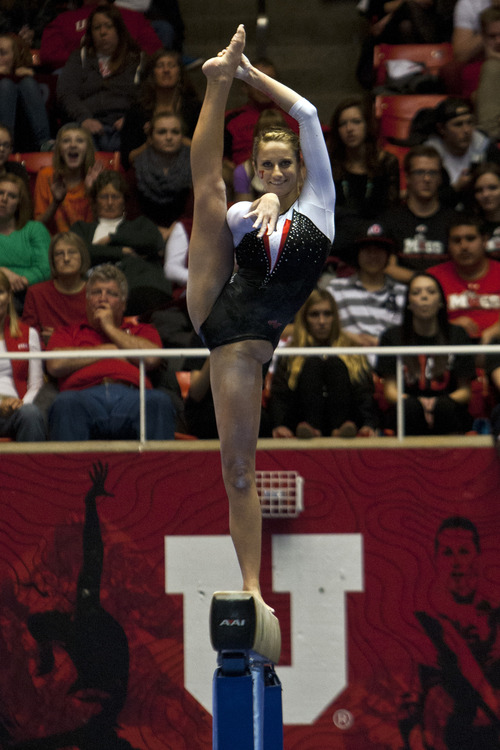This is an archived article that was published on sltrib.com in 2013, and information in the article may be outdated. It is provided only for personal research purposes and may not be reprinted.
If Utah gymnastics fans want to see Utah's meet against Arizona State on Friday, they've got two choices. They can brave the cold weather and join thousands of others in the stands at the Huntsman Center or they can stay home and huddle in front of a computer screen and watch the live video stream.
Obviously, for true fans, getting up to the Huntsman Center is the best chance they have for a quality viewing experience. If only the meet were on TV, they could have the best of both worlds — stay warm at home and see the action as it happens on a big screen.
Of course, if the Pac-12 has its way, fans' options are going to be different in the future thanks to live broadcasts on the Pac-12 Network. Giving minor sports such as gymnastics more TV time is a goal of Pac-12 commissioner Larry Scott.
Scott helped turn women's professional tennis tournaments into prime TV events and believes sports such as gymnastics are untapped mines for viewership for the fledgling TV network.
This year, the Pac-12 is broadcasting 10 gymnastics meets, including Utah's upcoming meet at Washington, which will be shown on tape delay, live broadcasts of the Utes' meets against Stanford and Florida and the Pac-12 Championships.
For many, including Utah coach Greg Marsden, that gymnastics meets even have a sniff of live TV coverage is a step in the right direction of recognizing the sport as legitimate.
Marsden likes to joke that if you aren't on TV, then in the sporting world you don't really exist.
"I've been a longtime advocate of live TV," he said. "I do think gymnastics is better tape delayed than some sports because you can go beyond the win-loss thing and appreciate the performance side of the sport itself, but being on TV has a lot of upside too."
Marsden has been such a supporter of TV coverage that he has long pushed for a format change to the NCAA Championships. Believing the Super Six format was too long and complicated for live TV due to the necessary byes, Marsden has been a vocal advocate of cutting the finals to four participating teams instead of six. The benefits, in his mind, would be an easier to follow format for those attending, a shorter event overall and a more TV-friendly production.
Coaches voted for the format in 2009 and approved it, then reversed their decision months later.
Just to prove a four-team meet could be held under two hours, the Utes went with a modified format for a recent quad meet in which the gymnasts performed one at a time. The meet lasted a little more than two hours but if the participants were all competing at once, it would have easily clocked in under the two-hour mark.
"We wanted to show that it could be done," Marsden said. "If TV wants to experiment with it, they can."
Marsden has found an ally in the Pac-12, which needs events to fill its network time. Officials were also "blown away" by the competition at the Pac-12 Championships held in Salt Lake City last year, said Kirk Reynolds, the vice president for communications for the Pac-12 Enterprises.
"The energy and the size of the crowd there, it was a slam dunk for us to decide gymnastics was something we were going to televise," he said. "It is a proven sport for Olympic TV coverage too with a rich tradition."
Reynolds said the league hasn't compiled viewership data for Utah's opener at UCLA but was satisfied with the production. Utah's gymnasts didn't notice anything different, save for a few extra cameras around.
"It's exciting to have a little more publicity," sophomore Tory Wilson said. "It makes it a little more nerve-wracking knowing we are on TV but it's good."
The one thing no one knows is how it will affect Utah's attendance. The advantage to not being on TV is fans really have no choice but to attend meets if they want to see the gymnasts perform.
That might be a disadvantage when it comes to general exposure, but it's an advantage when it comes to incentives for attending meets.
The Utes have averaged almost 14,000 fans the last four seasons, but how many of those would be willing to brave the elements if a meet is televised? No one knows the answer to that question.
"It could be a two-edged sword," Marsden said. "But I don't think it will hurt ticket sales. If we get to the point where the majority of our meets are televised, I don't know, that could be an issue, but if we want to keep growing as a sport, we have to get on TV. That is something you have to do to increase popularity."
For now, the Utes believe the TV exposure is all good, perhaps exposing them to fans who otherwise might not trek up to the Huntsman Center for their first view. Once they get them there, they think they have them hooked.
"It's an extra bonus," junior Corrie Lothrop said. "It's nice for the fans and families who can't make it, but we definitely want them in the Huntsman Center." —
California at Utah
O Saturday, 7 p.m.



